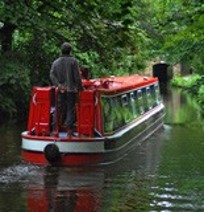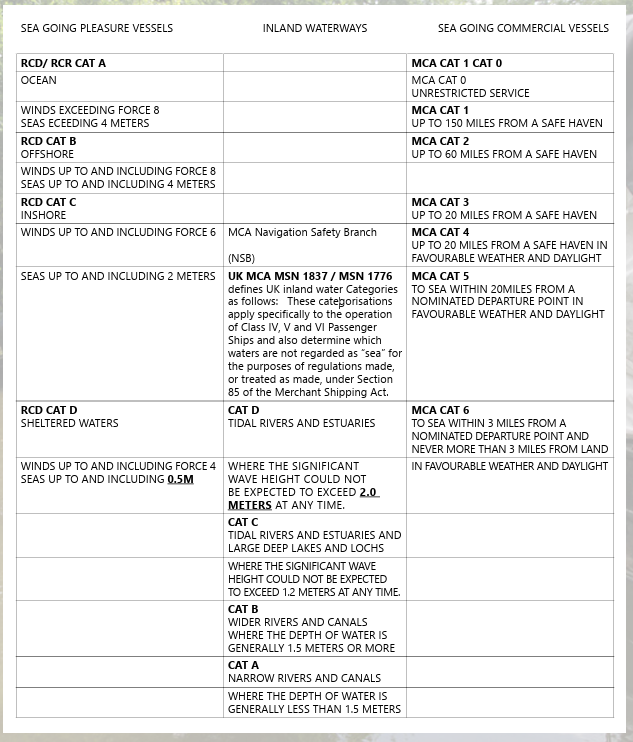
IIMS Past President, Geoff Waddington, is a successful yacht and small craft marine surveyor. Over the years he has written a number of articles, including some about the UK inland waterways sector. In this article, he sets out to explain and make sense of some of the confusion and inconsistencies that exist between the various current rules and regulations.
First of all, let’s consider the issue of conformity.
UK Government Legislation
- The Recreational Craft Regulations (RCR) 2017 (UK Legislation excluding originating from the EU).
- UK Statutory Instruments 2017 No. 737 Part 2 Manufacturer Regulation 16.
Duty to take action in respect of product placed on the market which is considered not to be in conformity.
- A manufacturer who considers, or has reason to believe that a product that it has placed on the market is not in conformity Part 2, must immediately take the corrective measures necessary to:
- bring the product into conformity;
- withdraw the product from the market; or
- recall it.
- Where the product presents a risk, the manufacturer must immediately inform the market surveillance authority and the competent national authorities in any Member State in which the manufacturer has made the product available on the market of the risk, giving details of:
- the reason why the product is not considered to be in conformity; and
- any corrective measures taken.
Stability and Freeboard
MGN 280 is a set of rules for vessels which proceed to sea, so this does not apply. However for comparison it is (200mm for 7m vessels 400mm for 18m vessels).
MCA (Maritime & Coastguard Agency) / AINA (Association of Inland Navigation Authorities) Inland Waters Small Passenger Boat Code is a Code of Practice for small commercial vessels operating in A,B,C & D waters which do not carry more than 12 passengers, do not carry cargo and do not go to sea.
All vessels should comply with the freeboard requirements given in Annex 9.
IN CATEGORY A and B WATERS
All vessels operating in category A waters, or decked vessels operating in category B waters, should have a minimum freeboard to deck edge or gunwale of 250mm around the periphery of the vessel in the most onerous loading condition. For open vessels operating in Category B waters, this requirement should be increased to 400mm if they are unable to pass the swamp test as detailed in Annex 8 Section 1.3.
IN CATEGORY C and D WATERS
Minimum freeboard to downflooding for vessels whose stability has not been assessed in conjunction with ISO 12217. 1. In the case of a vessel with a continuous watertight weather deck in accordance with decked vessels. In a decked vessel, which complies with the freeboard provisions of Section 12 and Annex 9 of this Code, efficient provision is to be made to clear the deck of water which may be taken onboard. Where water may get trapped, the vessel should have a minimum of two efficient freeing ports – one fitted port and one starboard. These ports should each have a clear area of: CATEGORY A & B CATEGORY C CATEGORY D 65sq cm, 135sq cm, 225sq cm.
These figures are based on maximum expected wave heights. Smaller ports may be suitable in a vessel having only small side deck areas, in which water can be trapped, the reduced area being based on the volume of water that is likely to become so trapped.
In the case of a vessel with a continuous watertight weather deck which is neither stepped nor recessed or raised, not in compliance with above should have a freeboard to downflooding of not less than:
- Category C 360 mm for vessels of 7 metres in length or under and not less than 630 mm for vessels of 18 metres in length or over.
- Category D 600 mm for vessels of 7 metres in length or under and not less than 1050 mm for vessels of 18 metres in length or over.
In the case of a vessel with a continuous watertight weather deck, it must have a freeboard to deck measured down from the lowest point of the deck of not less than: – Category C 120 mm for vessels of 7 metres in length or under, and not less than 240 mm for vessels of 18 metres in length or over. – Category D 200 mm for vessels of 7 metres in length or under, and not less than 400 mm for vessels of 18 metres in length or over.
In the case of an open boat, it should have a clear height of side, eg. the distance between the waterline and the lowest point of the gunwale* of not less than:
- Category C 240mm for vessels 7 metres in length or under, and not less than 480mm for vessels 18 metres in length or over.
- Category D 400mm for vessels 7 metres in length or under, and not less than 800mm for vessels 18 metres in length or over.
For a vessel of intermediate length, the freeboard should be determined by linear interpolation. For vessels complying with points 1 and 2 above, the freeboard to deck edge should, in general, be not less than 50% of the required freeboard to downflooding.
Freeboard Measurement
The boat should be tested with the maximum number of persons (passengers and crew) onboard, in the fully loaded condition i.e. with full tanks, full stores etc. The persons and equipment should be positioned as to represent the “in service” condition of the boat. The boat should be at its normal working trim and have no angle of heel. If so required, each person may be represented by a weight of 75kg. Arrangements should be made in order to allow a person outside of the vessel to take all measurements.
British Marine Inland Waterways Small Passenger Boat Code Stability & Freeboard Standards
- The angle of heel does not exceed 7 degrees, and
- In the case of a vessel with a watertight weather deck extending from stem to stern, the freeboard to downflooding is not less than 100 mm for MCA Category A waters or 175mm for MCA Category B waters. (Note: MCA Categories A & B are generally equivalent to RCR Category D) and additionally, the freeboard to deck is not less than 75mm at any point.
- The angle of heel may exceed 7 degrees, but should not exceed 10 degrees, if the least freeboard to downflooding in the heeled condition is in accordance with Section 3 of this Code for the upright condition.
British Marine Code of Practice for the construction of Inland waterways craft
- FREEBOARD. All vessels should have a minimum freeboard to deck edge or gunwale of 250mm around the periphery of the vessel in the most onerous loading condition. For open vessels this requirement should be increased to 400mm if they are unable to pass the swamp test as detailed in Section 1.3.
Simplified MCA MGN 280 Stability and freeboard test: A vessel should be tested in the fully loaded conditions. For the purposes of this code a person is taken to weigh 82.5 Kg. As in Workboat 3 code.
The vessel will be judged to have an acceptable standard of stability if the test shows that:
- The angle of heel does not exceed 7 degrees;
- In the case of a vessel with a watertight weather deck extending from stem to stern, the freeboard to deck is not less than 75mm at any point; or
- If unable to meet the criteria in b. The angle of heel may exceed 7 degrees, but should not exceed 10 degrees, if the freeboard in the heeled condition is in accordance with that required by Section 5 in the upright condition.
- In the case of a vessel with a continuous watertight weather deck which is neither stepped or recessed or raised, it should have a freeboard measured down from the lowest point of the weather deck of not less than 300 mm for vessels of 7 metres in length or under and not less than 750 mm for vessels of 18 metres in length or over. For a vessel of intermediate length, the freeboard should be determined by linear interpolation. b. In the case of a vessel with a continuous watertight weather deck which may be stepped, recessed, or raised, it should have a freeboard measured down from the lowest point of the weather deck, of not less than 200mm for vessels of 7 metres in length or under and not less than 400mm for vessels of 18 metres in length or over. For a vessel of intermediate length, the freeboard should be determined by linear. Interpolation. The raised portion(s) of the watertight weather deck should extend across the full breadth of the vessel and the average freeboard over the length of the vessel should comply with section 5 above for a vessel with a continuous watertight weather deck.
- In the case of an open boat, it should have a clear height of side (i.e. the distance between the waterline and the lowest point of the gunwale1) of not less than 400mm for vessels of 7 metres in length or under and not less than 800mm for vessels of 18 metres in length or over. For a vessel of intermediate length, the clear height should be determined by linear interpolation.
The Boat Safety Scheme (BSS)
Examples of inland waterway guidance where freeboard requirements are:
- All hull openings need to be watertight above the normal laden waterline to at least 10″ (250 mm).
- Self-draining cockpits do not need to meet the 250 mm if they have a sill of 150mm.
- Weedhatches need to be watertight to at least 6″ (150 mm).
The are a lot of variables in freeboard measurement and most of them are dependent on the design category. Unfortunately, the majority of Inland Waterways Craft have not been allocated a design category. By way of a slight diversion, this next section is an extract from a much longer article written for the 98th edition of The Report magazine, December 2021. It brings to light some of the issues with the Categorisation of UK Vessels both Recreational Craft and Small Commercial Vessel – (up to 24m).
‘Inland Waters’. Waters listed in MCA notice MSN 1776(M) or its Amendment 1872 as falling within the categories A to D, or waters not so listed but falling within the definitions given in MSN 1776(M), or controlled waters as defined in the Water Resources Act 1991. ‘Inland waters’ includes any area of water not categorised as ‘sea’ – e.g. canals, tidal and non-tidal rivers, lakes, and some estuarial waters (an arm of sea that extends inland to meet the mouth of a river). Inland waters are classified as one of four categories:
- Category A – narrow rivers and canals where the depth of water is generally less than 1.5 metres.
- Category B – wider rivers and canals where the depth of water is generally 1.5 metres or more and where the significant wave height could not be expected to exceed 0.6 metres at any time.
- Category C – tidal rivers, estuaries and large, deep lakes and lochs where the significant wave height could not be expected to exceed 1.2 metres at any time.
- Category D – tidal rivers and estuaries where the significant wave height could not be expected to exceed 2 metres at any time.
Some Inland Waterways Vessels do proceed “To Sea”. Therefore, we must also consider this. MGN 200 definition “To Sea” Means Beyond Category D waters, or Category C waters if there are no category D waters.
- Cat D Waters: ‘Sheltered waters’- significant wave height up to and including 0.5 meters.
- Cat C Waters: ‘Inshore’ significant wave height up to and including 2 meters.
- (Interpretation: Cat C Inland = in excess of Cat D Sea and Cat D Inland = the same as Cat C Sea, if you don’t go beyond Cat D waters or Cat C water if there are no Cat D waters you are not going to sea).
Inland waterways and categorisation of waters – the UK government documentation can be found at https://bit.ly/4h8BmZ1.
To view and browse a detailed list of UK categorised waters by location go to https://bit.ly/4ai9waz.
The RCD (Recreational Craft Directive) under ISO 12217 (Stability) designates Private Recreational Craft as suitable to operate in the following Categories:
“Design Category” means a description of the wind and sea conditions for which a vessel is considered suitable under the EU Recreational Craft Directive 94/25/ EC of 16th June 1994 and is used for the application of relevant ISO and CEN standards. Design category wind force significant wave height (Beaufort scale) (H 1/3, metres)
- ‘Ocean’. Exceeding 8 Significant Wave Height Exceeding 4.
- ‘Offshore’. Up to, and including, 8, Significant Wave Height Up and including 4 metres.
- ‘Inshore’. Up to, and including, 6 Significant Wave Height Up and including, 2 metres. (This would be MCA CAT D). D
- ‘Sheltered waters’. Up to, and including, 4 Significant Wave Height Up and including, 0.5 metres (This would be MCA CAT C).
The MCA currently accept these categories as evidence of suitability when considering their own SCV (Small Commercial Vessel Code) categories.
A vessel may be considered for the issue of a Small Commercial Vessel certificate allowing it to operate in one of the following areas:
- Area Category 6: To Sea, within 3 miles (beyond CAT D or CAT C waters where there are no CAT D) from a nominated departure point(s) named in the certificate and never more than 3 miles from land, in favourable weather and daylight;
- Area Category 5: To Sea, within 20 miles (beyond CAT D or CAT C waters where there are no CAT D) from a nominated departure point named in the certificate in favourable weather and daylight.
- Area Category 4: Up to 20 miles from a safe haven, in favourable weather and in daylight;
- Area Category 3: Up to 20 miles from a safe haven;
- Area Category 2: Up to 60 miles from a safe haven;
- Area Category 1: Up to 150 miles from a safe haven;
- Area Category 0: Unrestricted service.

My question in regard to categorisation of waters is…
The cross-over between RCD Cat D waters and MCA Cat D waters is inconsistent. There is a significant difference between 0.5 metre waves and 2.0 metre waves. There is consistency between Sea Going Pleasure Vessels and Sea Going Commercial Vessels So, why do Inland Waterways Pleasure Vessels not have the same restrictions of areas of use as Inland Waterways Commercial Vessels?
The MCA continues to be setting the standards for construction and maintenance of inland waterways craft. As mentioned earlier a Code of Practice for Inland Waters Small Passenger Boats in cooperation with
The Association of Inland Navigation Authorities and British Marine has been produced for inland boatbuilding.
Unfortunately, all this means is that there are a number of rules and standards and also a number of associations involved – in fact over 60 different inland waterways authorities at my last count.
MGN 469 (M) Amendment 1 (November 24, 2023) Inland Waterways nonpassenger vessels:
Applicable safety standards for vessels operating solely on inland waterways in the United Kingdom states:
- “Inland waterways” means: “Categorised Waters”, as defined and listed in MSN 1837 (as amended); or other Inland Waters that have not been formally categorised but have the same characteristics of Category A, B, C or D waters as defined in MSN 1837 (as amended).
- “Inland Waterway nonpassenger vessel” means a vessel that does not go to sea and does not carry more than 12 passengers as part of its normal operations.
- This includes, but is not restricted to:- dry freight vessels;- tanker vessels;- container vessels;- workboats, including specialist vessels such as crane barges or dredgers; – and tugs and pushers.
It would appear that there is a difference of opinion in the average weight of a person which in inland waterways can either be 75kg or 82.5 kg. (There was also an issue raised in part of my research on Inland Waterways vessels which referred to a sill of more than 50mm being considered a trip hazard, but I think we should ignore that).
Prior to Brexit and even during the years of transition we had the RCD and EU rules and regulations, most of which have been incorporated into the UK RCR because they are borne out of the ISO’s which form their basis.
Pre Brexit, one Inland Waterways vessel manufacturer stated: The RCD is a grey area for quite a few people, and a complete mystery to the rest of us. It is effectively a CE mark for a boat. It is poorly policed in the UK and many boats sold on the market, both new and used, fail to comply with the regulations, particularly as in the case of boats classed as Category D (which includes all narrow boats) the builder self- declares without any requirement for an independent inspection.

This is why the majority of Inland Waterways vessels were never certified to the required standards of conformity. All these variables and a lack of conformity and compliance lead to the reasons why we find ourselves so confused in regard to Inland Waterways craft.
By Geoff Waddington, Past President and HonFIIMS